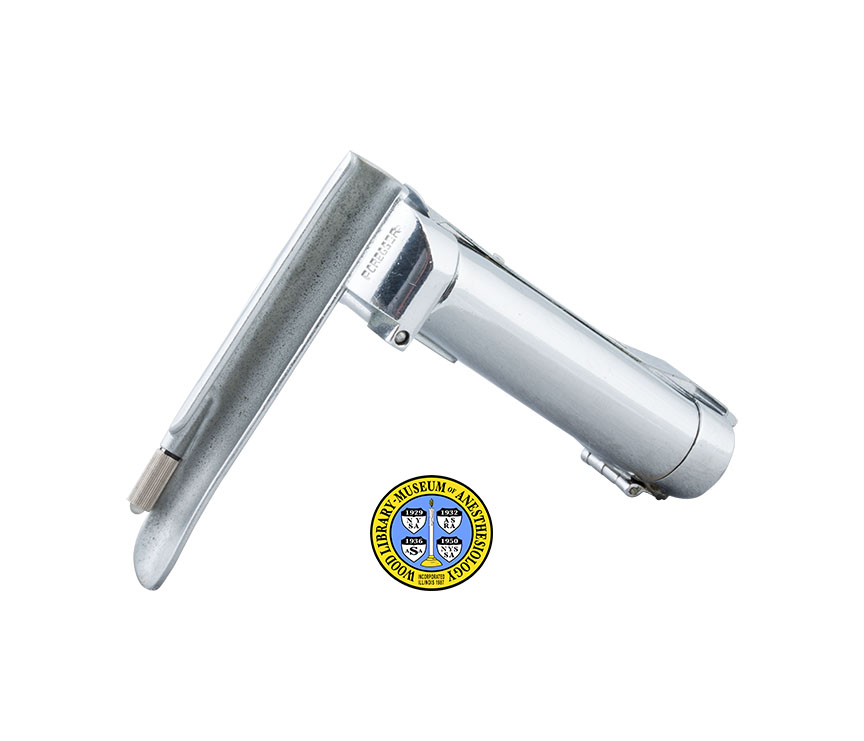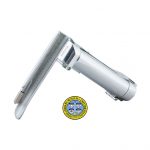Foregger Miniature Laryngoscope
This laryngoscope, made by the Foregger Company, measures less than 3.5 x 1.5 x 3 inches in height, width and depth. It was devised by pediatric anesthesiologist Robert M. Smith, M.D. (1912-2009), in the 1950s for use with infants. Anesthesiologists use laryngoscopes to gently lift the tongue and tissue in the throat to see the opening to the windpipe. This allows for the safe insertion of an endotracheal (breathing) tube that carries oxygen and anesthetic gases to the patient's lungs.
Dr. Smith thought that a small-sized handle would encourage the kind of gentle movements called for when working with infants. The laryngoscope is shown here with a Miller-type blade. Wis-Hipple, Guedel, MacIntosh and Miller Premature blades were also available.
During WWII, Dr. Smith served as Chief of Anesthesia with the 100th General Hospital, providing medical support and anesthesia care to soldiers fighting in military campaigns in France and Germany. After his discharge from the Army in 1946, he joined the staff at Children’s Hospital Boston as the hospital’s first physician Chief of Anesthesia. During his 34 years at the hospital, Dr. Smith became a pioneer of pediatric anesthesiology and shared his knowledge by training more than 800 residents.
In 1959, he published the first edition of Anesthesia for Infants and Children, one of the earliest textbooks on pediatric anesthesiology. He published three more editions before handing over editorship. The book remains a core title in anesthesia education and is currently in its 8th edition.
Catalog Record: Foregger Miniature Laryngoscope
Access Key: amac
Accession No.: 2011-11-17-1
Title: Miniature [‘scope] : Miller [blade] / Foregger.
Corporate Author: Foregger Company.
Title variation: Alt Title
Title: Foregger miniature laryngoscope with Miller blade.
Title variation: Alt Title
Title: Infant laryngoscope.
Publisher: [Roslyn Heights, New York] : Foregger , [between 1953 and 1977?].
Physical Descript: 1 laryngoscope : metals, glass ; 8.5 x 3.5 x 7.5 cm.
Subject: Laryngoscopes – straight blades.
Subject: Anesthesia, Pediatric – instrumentation.
Subject: Airway Management – instrumentation.
Subject: Airway Management Equipment.
Subject: Smith, Robert M. (Robert Moors), 1921-2009.
Note Type: General
Notes: The early year in the date range is based on the first Foregger catalog in
which the miniature laryngoscope was first published (1955) and the previous
catalog (1952). Also, the miniature laryngoscope was first described in the
journal Anesthesiology in 1956, where it was called an “infant laryngoscope”.
The end date is based on the last catalog in which the miniature laryngoscope
was found to be published (1962) and the following catalog (1978). For
clarity, the laryngoscope is not in the 1952 or 1978 catalogs. The date range
could change if documentation, or expert opinion, indicates that it should be
corrected.
Note Type: General
Notes: The title was taken from markings on the laryngoscope and from the first
catalog in which the miniature laryngoscope was found (1955). The name
changed from “Miniature ‘Scope” to “Miniature Laryngoscope” in the 1962
catalog.
Note Type: Citation
Notes: Anesthesia Apparatus. Roslyn Heights, N.Y.: Foregger Co. Inc.; 1962:43.
Note Type: Citation
Notes: Catalog No. 12. New York: Foregger Company, Inc.; 1955:140.
Note Type: Citation
Notes: Catalog No. 15. New York: The Foregger Company, Inc., 1959:137.
Note Type: Citation
Notes: Holzman RS. A tribute to Dr Robert M. Smith: an appreciation of Robert Moors
Smith MD, an icon of pediatric anesthesiology. Pediatr Anesth.
2010;20(8):767-770.
Note Type: Citation
Notes: Infant laryngoscope. Anesthesiology. 1956;17(3):364.
Note Type: Citation
Notes: Rockoff MA, Bird H, Hendren WH, et al. Robert Smith: faculty of medicine
memorial minute. Harvard Gazette website. https://news.harvard.
edu/gazette/story/2010/09/robert-smith/. Published September 2, 2010.
Accessed June 26, 2015.
Note Type: Citation
Notes: Rockoff MA, Waisel DB. In memoriam: Robert Moors Smith, M.D., 1912-2009. ASA
Newsl. 2010;74(3):50-51.
Note Type: Physical Description
Notes: A laryngoscope with an infant or premature infant size blade and a handle
that can old two “AA” batteries; The measurements and description are based
on a patient perspective; The handle has rounded sides with a hinged distal
end that is held in place by a lever; Stamped into the distal end are
“MINIATURE” and “FOREGGER”; The blade is also fixed to the handle via a hinge
and lever; Stamped into the blade are, “MILLER” and “FOREGGER”; There are a
number of small scratches to the surface of the laryngoscope, which is
otherwise is in good condition.
Note Type: Reproduction
Notes: Photographed for the WLM by Mr. Steve Donisch, January 13, 2015.
Note Type: Acquisition
Notes: Donated to the WLM by Nancy Saade, MD.
Note Type: Historical
Notes: This laryngoscope, made by the Foregger Company, measures less than 3.5 x 1.5 x 3 inches in height, width and depth. It was devised by pediatric anesthesiologist Robert M. Smith, M.D. (1912-2009), in the 1950s for use with infants. Anesthesiologists use laryngoscopes to gently lift the tongue and tissue in the throat to see the opening to the windpipe. This allows for the safe insertion of an endotracheal (breathing) tube that carries oxygen and anesthetic gases to the patient’s lungs.
Dr. Smith thought that a small-sized handle would encourage the kind of gentle movements called for when working with infants. The laryngoscope is shown here with a Miller-type blade. Wis-Hipple, Guedel, MacIntosh and Miller Premature blades were also available.
During WWII, Dr. Smith served as Chief of Anesthesia with the 100th General Hospital, providing medical support and anesthesia care to soldiers fighting in military campaigns in France and Germany. After his discharge from the Army in 1946, he joined the staff at Children’s Hospital Boston as the hospital’s first physician Chief of Anesthesia. During his 34 years at the hospital, Dr. Smith became a pioneer of pediatric anesthesiology and shared his knowledge by training more than 800 residents.
In 1959, he published the first edition of Anesthesia for Infants and Children, one of the earliest textbooks on pediatric anesthesiology. He published three more editions before handing over editorship. The book remains a core title in anesthesia education and is currently in its 8th edition.
Note Type: Exhibition
Notes: Selected for the WLM website (noted March 31, 2015).


